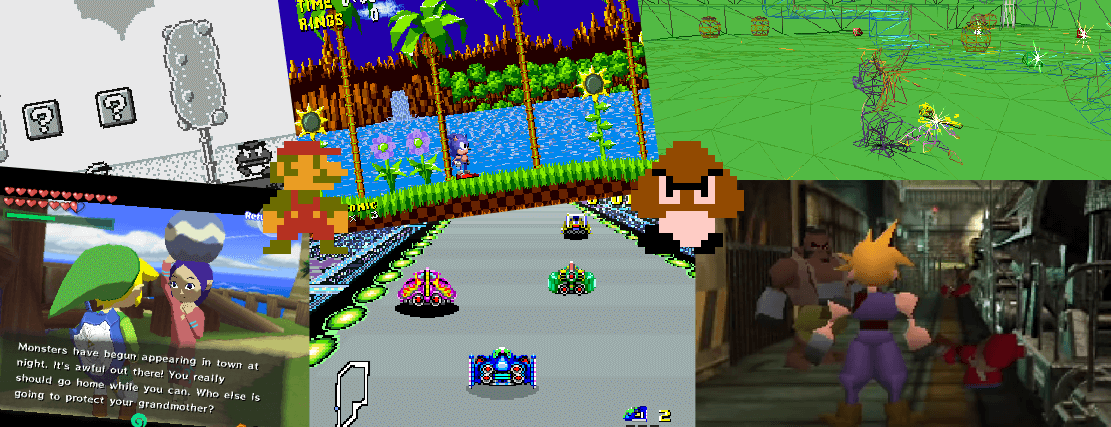
Verfügbare Sprachen: 🇬🇧 - English, 🇭🇺 - Magyar, 🇩🇪 - Deutsch, 🇵🇱 - Polski, 🇨🇿 - Čeština, 🇩🇰 - Dansk, 🏴 - Galego, 🇪🇸 - Español, 🇧🇷 - Português (Brasil), 🇮🇩 - Bahasa Indonesia, 🇹🇷 - Türkçe, 🇫🇷 - Français, 🇮🇹 - Italiano, 🇷🇺 - Русский, 🇺🇦 - Українська, 🇦🇪 - اَلْعَرَبِيَّةُ, 🇯🇵 - 日本語, 🇨🇳 - 简体字, 🇹🇼 - 正體字, 🇰🇷 - 한국어, 👋 - Übersetzung hinzufügen

Der Blick auf die Entwicklung von Videospielkonsolen ist faszinierend. Während sich herkömmliche PCs tendenziell “inkrementell” entwickeln, führt jede neue Generation von Konsolen völlig neue Arbeitsweisen ein. Was Sie hier sehen, ist eine Reihe von Artikeln, die hoffentlich die Gründe für die neuesten Technologietrends aufdecken und auch aufzeigen, Warum sich nicht jedes System nach seinen “Bits”, Megahertz, der Menge an RAM und so weiter zusammenfassen lässt.
Dies ist kein Entwicklerhandbuch, sondern bietet im Wesentlichen eine ausführliche Einführung in die interne Funktionsweise der einzelnen Systeme. Denken Sie daran, dass die Technik in letzter Zeit sehr kompliziert geworden ist. Wenn Sie also Schwierigkeiten haben, meinen neuesten Artikeln zu folgen, versuchen Sie, zuerst die ersten zu lesen. Sie können Ihnen als Einführung in viele Konzepte und Definitionen dienen.
Grundkenntnisse in der Informatik sind von Vorteil, aber ich bemühe mich wirklich sehr, meinen Inhalt für ein breiteres Publikum zu schreiben, also scheuen Sie sich bitte nicht, es zu versuchen! Aber wenn das nicht genug ist, solltest du dir die Unterstützende Lesungen ansehen.
Ich versuche, so genau wie möglich zu sein, sollten Sie dennoch Fehler finden, bitte benachrichtigen Sie mich. Wenn Sie es vorziehen, auf einem E-Reader zu lesen, schauen Sie sich die eBook-Edition an.
Kurzerhand, hier sind sie!
Diese als "8-Bit"-Konsolen bekannten Geräte brachten anspruchsvollere Grafiken und reichhaltigere Sounds als ihre Vorgänger. Schließlich war der Markt gerade zusammengebrochen und es mussten neue Standards gesetzt werden.
Hervorragende GPU-Funktionen: Bewegliche Karten und größere Farbpaletten.
DMA, horizontale Interrupts, mehrere Modi... Dies sind nur einige Beispiele für die neuen Konzepte, die die neue "16-Bit"-Generation hervorbrachte und die Tür zu neuen Spielgenres öffnete.
Bemerkenswerte CPU-Fortschritte: Multiplikations- und Divisionsbefehle, DMA und Dual-Processing.
Hervorragende GPU-Funktionen: Affine Abbildungen und Rasterzeileninterrupts.
3D-Spiele sind mittlerweile eine Notwendigkeit, aber das "Wie" ist noch nicht klar. Die Antwort? Jedes Unternehmen präsentierte seine eigene Vision.
Bemerkenswerte CPU-Fortschritte: Pipeline-Stufen und L1-Cache.
Hervorragende GPU-Funktionen: Programmierbare Vertex-Pipelines, Z-Pufferung und perspektivische Korrekturen.
Die meisten grafischen Beschränkungen der vorherigen Generation sind nicht mehr vorhanden. Tragbare Konsolen beginnen, vertrauten Systemen zu ähneln.
Bemerkenswerte CPU-Fortschritte: Superskalare Architekturen, SIMD-Befehle und L2-Cache.
Hervorragende GPU-Funktionen: Programmierbare Pixel-Pipelines und anisotrope Filter.
Konsolen haben sich zu Supercomputern und Multimedia-Zentren entwickelt. Diese Geräte können jetzt mehr als nur Spiele spielen, weshalb die Sicherheit jetzt ein entscheidender Faktor ist.
Bemerkenswerte CPU-Fortschritte: Parallelität auf Thread-Ebene und symmetrische Multicore-Architekturen.
Hervorragende GPU-Funktionen: Vereinheitlichtes Shader-Modell und HDR-Rendering.
Der Unterhaltungsmarkt wurde inzwischen von billigen Smartphones und Tablets erobert. Social-Media-Fähigkeiten werden zur ersten Priorität eines jeden Endgeräts. Es ist an der Zeit, dass die traditionellen Videospielunternehmen ihren Status quo überarbeiten - und das am besten schnell.
Es gibt viele Konsolen, über die ich schreiben könnte... Wenn Sie sich fragen, was als nächstes auf meiner Liste steht, hier ist es:
#### Personal computers repackaged as consoles
Wenn Sie meine Artikel interessant finden, dann erwägen Sie bitte eine Spende. Ihre Beitrag wird verwendet, um den Kauf von Werkzeugen und Ressourcen zu finanzieren, die mir helfen, die Qualität der bestehenden Artikel und der kommenden zu verbessern. Ich stelle auch eine Liste von interessanten Materialien zur Verfügung, die am Ende jedes Artikels erworben werden können.


Sie können auch die eBook-Ausgabe auf Englisch kaufen. Ich betrachte Gewinne als Spenden.

Als Zeichen der Dankbarkeit wird Ihr Name im Abschnitt Credits des nächsten Artikels oder Ihres nominierten Artikels aufgeführt, sofern nicht anders angegeben.
If you want to know more about this series, here I've compiled common questions that people have asked me in the past.
Because I believe it’s the best way to properly comprehend present (and future) technology. Current advancements don’t pop out of nowhere, they may even carry past technology that only became popular many years later. Moreover, learning the fundamentals also allows me to filter misinformation out (which I’ve seen plenty of).
Apart from that, it’s continuous food for thought.
Definitely! I already started compiling the series and actively expanding. Furthermore, if you’re an editor/publisher and would like to work together on this, please get in touch.
Chances are I’d like to, however, time and budget are my main constraints.
Please open an issue on the Github repo so I can review it (and other people can contribute as well).
I don’t mind being wrong! But I can only do so much if people keep the corrections for themselves or only discuss them on a separate forum.
The point of the articles is so you can form an educated opinion by yourself. Although, nothing beats the Nintendo Switch U 64 OLED!
You can also check out the about page or drop me a line.